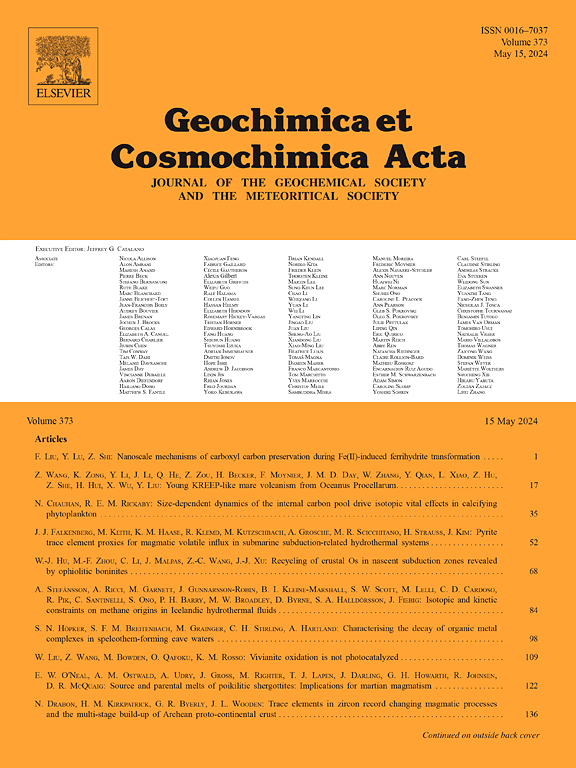Foraminiferal denitrification and deep bioirrigation influence benthic biogeochemical cycling in a seasonally hypoxic fjord
IF 4.5
1区 地球科学
Q1 GEOCHEMISTRY & GEOPHYSICS
引用次数: 0
Abstract
Benthic macro- and micro-biota often play significant roles in controlling the biogeochemical dynamics in sediments. Their activity can be influenced by oxygen availability and impacted by the rise in global hypoxia in coastal regions over the last decades. To understand how these organisms interact with coastal hypoxia and influence sediment biogeochemistry, we undertook a study of early diagenesis in Bedford Basin, a seasonally hypoxic fjord on the West Atlantic coast in Nova Scotia, Canada, using a combination of observations and reaction-transport modeling. We observed that the seafloor was a source of ammonium and sink of nitrate with average fluxes of 2.2 ± 1.8 and −0.9 ± 0.7 mmol m−2 d−1 respectively. The diffusive oxygen uptake was 14 ± 4.6 mmol m−2 d−1 and the total organic carbon content in collected sediment cores was 5–7 % with a C/N ratio of ∼10. The pyrite content increased steadily from 0.5 wt% Fe at surface to ∼2 wt% Fe at 20 cm depth. Hydrogen sulfide was negligible down to 25 cm depth most of the time. The sediment was inhabited by tube-forming polychaete Spiochaetopterus sp. that formed tubes up to ∼30 cm in length. The living foraminiferal assemblage in the top 5 cm sediment was found to be dominated (>85 %) by nitrate-storing and denitrifying benthic foraminifera Stainforthia fusiformis. These observations were used to develop and constrain a biogeochemical reaction-transport model. The model results suggest that the observed decrease in porewater concentrations of ammonium and dissolved inorganic carbon below 5 cm depth, was due to deep bioirrigation by tubeworms, accounting for almost 50 % of the benthic efflux. The model further revealed that the deep bioirrigation along with bioturbation and iron cycling prevented accumulation of free sulfide in the top 25 cm sediment despite oxygen penetration depths of ∼1 mm. Modelled organic carbon and nitrogen deposition was 25.2 and 2.9 mmol m−2 d−1 with burial efficiencies of 23 % and 17 %, respectively. The model indicated a total denitrification rate of 1.3 mmol N m−2 d−1 that was largely (∼70 %) driven by benthic foraminifera. This study reports the first evidence of foraminiferal denitrification in western Atlantic coastal sediments, and suggests that eukaryote mediated denitrification is an important driver of sediment N-loss in seasonally hypoxic environments, a process that has been traditionally assumed to be carried out by prokaryotic microbes.
求助全文
约1分钟内获得全文
求助全文
来源期刊

Geochimica et Cosmochimica Acta
地学-地球化学与地球物理
CiteScore
9.60
自引率
14.00%
发文量
437
审稿时长
6 months
期刊介绍:
Geochimica et Cosmochimica Acta publishes research papers in a wide range of subjects in terrestrial geochemistry, meteoritics, and planetary geochemistry. The scope of the journal includes:
1). Physical chemistry of gases, aqueous solutions, glasses, and crystalline solids
2). Igneous and metamorphic petrology
3). Chemical processes in the atmosphere, hydrosphere, biosphere, and lithosphere of the Earth
4). Organic geochemistry
5). Isotope geochemistry
6). Meteoritics and meteorite impacts
7). Lunar science; and
8). Planetary geochemistry.
 求助内容:
求助内容: 应助结果提醒方式:
应助结果提醒方式:


